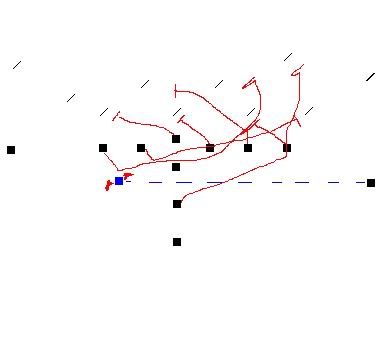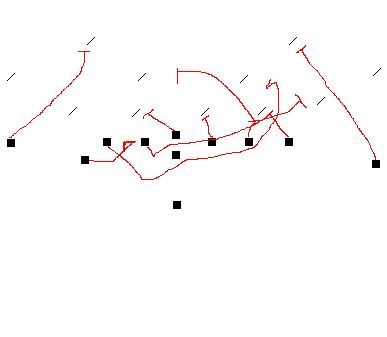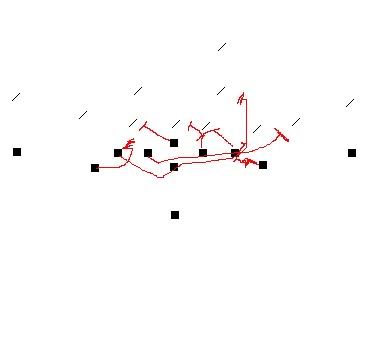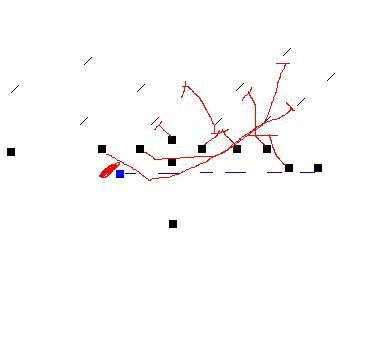- Joined
- Jul 24, 2009
- Messages
- 593
- Reaction score
- 14
- Points
- 18
- Alma Mater

Posted this at the other place, but I feel like you guys will enjoy this one. Forgive me for posting in two places 
Joe Bugel, the head honcho of the Hogs, was part of a brain trust of our three Super Bowl wins. Bugel will tell you himself, however, that the entire offense was installed by the entire offensive staff at Joe Gibbs wishes. That meant the OL coach knew the receivers responsibilities just as well as the RB coach knew the QBs. Everything was done together, as one, with unity.
Obviously, Coach Bugel and Gibbs really enjoyed running the football. For those that don't know, Buges worked with Woody Hayes and Bum Phillips as well as Joe Gibbs in his stints as an offensive line coach. So he worked with some absolutely outstanding football minds.
Woody Hayes was a guy who, for all intents in purposes, went into the game planning on running the ball 73 out of 75 times, and as Buges says, "those two passes might be two button hooks".
Bum Phillips kept it simple, he only had a hand full of offensive plays at the team's disposal. Which was different than Coach Gibbs. Gibbs came in with the Air Coryell playbook. Twenty plus run combos, various pass protections, and over 150 route combinations. The first thing Buges and Gibbs did when they got to Washington was to parse down the playbook. There were a few running plays in their arsental, but Buges speaks most highly of 40/50 Slant, 40/50 Gut and the Counter Game.
One of the biggest things about Gibbs and Buges was that they wanted to practice every day in full pads, with the idea that as the season went on their guys would be so calloused they'd be in better shape than their opponents. And it helped them win three Super Bowls. But they weren't dumb by the same token. They didn't go full go in these practices, they wanted to keep everyone up.
In my last Chalk Talk, about Tight Zone, I talked about Alex Gibbs and how he utilized the cut block in one of the replies. Joe Bugel doesn't believe in the cut block. He likes to keep big guys upright.
One of the itneresting things about Buges, is he didn't make the left side of the line get in a left handed stance (A left handed stance is where your left foot is back and your left hand is down. It's utilized to keep your kick foot back in pass protection to help you get depth quicker and prevent penetration from the defensive end). Everyone has their style, and you can't argue Buges success.
Let's start out with the most famous play of them all. The HS team I coach runs this play, except we call it "Redskin" in honor of the team that made this play famous. This was the Redskins' bread and butter run series:
Counter Trey
The "Trey" portion is the famous part of the play, but it's not the only way to run counter, and the 'Skins changed what they did against different defenses and looks. The counter part was their staple, the trey just became famous verbiage.

First off, any blue on the diagram is a motion. Any red is a block.
This is based against a 3-4 defense, which the Giants ran with a guy named Lawrence Taylor... You may have heard of him.
Basically, in the counter game, you always want a double team playside and one or two pulls coming from the backside. Definition wise, playside is the side where the play is designed to go, and backside is the side that's "behind" the play.
So, in the counter trey vs. the 3-4, the TREY block itself it the TE/T double team on the defensive end. You see that on the right side of the diagram. The TE takes an inside "gap" step, sealing off his gap and exploding into the defensive end. The tackle steps to the defensive end and also explodes into him. But he only does so for two steps, he then peels off and finds the FAR linebacker.
The playside guard blocks down on the nose. Angles are important and he has a great one.
The center is going to do something that Buges refers to as, "break glass". Basically, that son of a gun is turning and running until he hits something. Ideally, you want it to be the backside defensive end.
The backside guard is going to pull off the center's butt. His job on counter is to always hit the first man outside the playside tackle. In this case, although I don't list the position, it's the SAM (strongside backer).
The backside tackle is pulling as well, but he's going to get a yard of depth deeper than the guard. Why? If that End breaks through, he can easily disrupt the flow of the play, so by getting depth, the tackle can stay on his assignment without disruption. When he pulls, he's staying in the guards hip pocket, looking off his own inside shoulder. He'll then peel off and block the near backer, which in this instance is the MIKE.
As you can see, the Z receiver motions in this version of the play, and his only job is to create a wall where he stops his motion. He CANNOT allow backside penetration. Whether it's the end of the WILL backer, he MUST slow them down.
The HB is aligned in the I formation on this play. At the snap, he's going playside and off the butt of the TE then going directly to the strong safety.
The tailback is going to take a jab step to the backside to get the linebackers to flow, then he's cutting back and following his pulling linemen.
The counter trey could also be run against a 4-3 UNDER defense which is diagrammed here:

This time, the HBack is aligned on the left side of the formation, off the line of scrimmage. The TE (or Y) is on the line of scrimmage on the right side of the formation. It's a TREY block, which again, means TE/T double team.
So the TE/T double the end. After two steps, the tackle once again aborts and goes to the far backer.
The playside guard is going to take the angle on the 1-tech defender (1-tech = defender in the A-Gap) and blow him out of the play.
The center is "breaking glass" again, and MUST blow up that 3-tech defender. If that 3-tech is a real pain in the ass, the HB is going to help, I'll explain that in a second.
The backside guard is pulling, hitting the first man passed the tackle on the playside, which is again the SAM backer.
The backside tackle is also doing the same. Getting a yard deeper than the guard and blowing up the MIKE backer.
The HBack's role changes a bit. He's replacing the pulling guard once the tackle gets out of the way. He's the seal player, or the wall player, like the Z was in the first diagram vs. the 3-4 defense. He can help seal the 3-tech if the center struggles, or, ideally, he will seal off the defensive end to stop backside penetration.
The tailback takes the jab step and goes follows his blockers. Once again, the jab is to create linebacker blow to the wrong direction.
Here's one of my favorite "Bugeisms". The receivers go to block the safeties. Why not the corners? Because, as Buges says, "they're zombies" because if they try to make the tackle against the 'Skins backs, their "dead men walking".
So far, you've seen the TREY version of counter diagrammed twice against different defenses. Well, now we'll get into Counter Deuce Angle

If a TREY was a TE/Tackle block, one could logically assume a DEUCE is a tackle/guard block. And if you did, you'd be correct
The premise is the same, and this play is being run against a 46 defense, much like Buddy Ryan's Eagles ran.
The TE (or Y) is shutting down his inside gap and sealing the defensive end.
The PSG (playside guard) and PST (playside tackle) are doubling the 3-technique (defensive linemen aligned on the outside shoulder of the guard). They double for two steps, then the guard breaks off and takes on the nose tackle.
The center is breaking glass again, attacking the defensive end on the backside.
The BSG (backside guard) and BST (backside tackle) are once again pulling. Guard blocks first man outside the tackle (which some could argue is the end, but we've taken care of him, so he goes to the SAM). The tackle looks inside to MIKE.
The HB is the seal player yet again.
This next one is a double tight formation. In this diagram, there is a TE on the LOS on the right side of the formation. There is ANOTHER tight end off the LOS directly next to him. And directly next to him is the HB.
I present you Counter Load O.T. (O.T. is simply OFF TACKLE)

I like this play a lot because there are two double teams.
First off, the HB is the motion man. He sets up and creates the wall to seal the backside to prevent penetration, just like he has in other versions and the Z does in the first version we went over.
The two tight ends are going to seal their gap and double team, once again, for two steps. After two steps, the inside aligned TE (the one on the LOS) aborts and he attacks the NEAR backer.
You get another DEUCE block with the PSG and PST. After two steps, the PSG aborts and goes to the FAR backer.
Center breaks glass on the 1-tech.
BSG/BST pull.
Now, let's change course. Buges ran this next one with the Raiders when he had Napoleon Kauffman as his back. Kauffman was a quick little bastard.

This one is called Counter O.F. (Off Fullback)
There are two receivers aligned to the left of the diagram. The fullback is offset in a WEAK I formation.
If the DE on the playside is aligned outside the tackle, and the SAM is walked up on the LOS outside the TE, the PST will make a "TRIGGER" call.
Basically, they're taking their guys in a man blocking scheme.
The PSG is going to block down and take on the 1-tech.
On this version of the play, the center does NOT break glass. He shuffle steps to replace the pulling guard. He's responsible for the 3-tech.
The BSG pulls and will pick up the MIKE this time, because the SAM has been accounted for.
That means the BST doesn't have a responsibility. So what he does is take a shuffle step inside to seal the B-Gap (the gap between the guard and tackle) and then swings to prevent the defensive end from penetrating.
The X receiver (the slot receiver on the left of this diagram) goes to the strong safety who is walked up in the box.
The fullback has the most important role on this play. He needs to come RIGHT off the pulling guard's hip and pick up the WILL linebacker.
First off, I know my diagrams blow. I apologize
But this was the counter game that we know and love. The Redskins also had several other versions, including O.Y. (Off Tight End), a pass, a screen and a reverse off of it. That kept defenses honest. They couldn't commit completely to stopping the Trey, or Deuce because then good ol' Saint Joe would hit them with some trickery.
Hope this was helpful to some wanting to learn more about our counter game, let me know if you have anything to add or any questions. I'll answer them the best I can. Although, let's remember, I'm not Joe Bugel
Joe Bugel, the head honcho of the Hogs, was part of a brain trust of our three Super Bowl wins. Bugel will tell you himself, however, that the entire offense was installed by the entire offensive staff at Joe Gibbs wishes. That meant the OL coach knew the receivers responsibilities just as well as the RB coach knew the QBs. Everything was done together, as one, with unity.
Obviously, Coach Bugel and Gibbs really enjoyed running the football. For those that don't know, Buges worked with Woody Hayes and Bum Phillips as well as Joe Gibbs in his stints as an offensive line coach. So he worked with some absolutely outstanding football minds.
Woody Hayes was a guy who, for all intents in purposes, went into the game planning on running the ball 73 out of 75 times, and as Buges says, "those two passes might be two button hooks".
Bum Phillips kept it simple, he only had a hand full of offensive plays at the team's disposal. Which was different than Coach Gibbs. Gibbs came in with the Air Coryell playbook. Twenty plus run combos, various pass protections, and over 150 route combinations. The first thing Buges and Gibbs did when they got to Washington was to parse down the playbook. There were a few running plays in their arsental, but Buges speaks most highly of 40/50 Slant, 40/50 Gut and the Counter Game.
One of the biggest things about Gibbs and Buges was that they wanted to practice every day in full pads, with the idea that as the season went on their guys would be so calloused they'd be in better shape than their opponents. And it helped them win three Super Bowls. But they weren't dumb by the same token. They didn't go full go in these practices, they wanted to keep everyone up.
In my last Chalk Talk, about Tight Zone, I talked about Alex Gibbs and how he utilized the cut block in one of the replies. Joe Bugel doesn't believe in the cut block. He likes to keep big guys upright.
One of the itneresting things about Buges, is he didn't make the left side of the line get in a left handed stance (A left handed stance is where your left foot is back and your left hand is down. It's utilized to keep your kick foot back in pass protection to help you get depth quicker and prevent penetration from the defensive end). Everyone has their style, and you can't argue Buges success.
COUNTER GAME
Let's start out with the most famous play of them all. The HS team I coach runs this play, except we call it "Redskin" in honor of the team that made this play famous. This was the Redskins' bread and butter run series:
Counter Trey
The "Trey" portion is the famous part of the play, but it's not the only way to run counter, and the 'Skins changed what they did against different defenses and looks. The counter part was their staple, the trey just became famous verbiage.

First off, any blue on the diagram is a motion. Any red is a block.
This is based against a 3-4 defense, which the Giants ran with a guy named Lawrence Taylor... You may have heard of him.
Basically, in the counter game, you always want a double team playside and one or two pulls coming from the backside. Definition wise, playside is the side where the play is designed to go, and backside is the side that's "behind" the play.
So, in the counter trey vs. the 3-4, the TREY block itself it the TE/T double team on the defensive end. You see that on the right side of the diagram. The TE takes an inside "gap" step, sealing off his gap and exploding into the defensive end. The tackle steps to the defensive end and also explodes into him. But he only does so for two steps, he then peels off and finds the FAR linebacker.
The playside guard blocks down on the nose. Angles are important and he has a great one.
The center is going to do something that Buges refers to as, "break glass". Basically, that son of a gun is turning and running until he hits something. Ideally, you want it to be the backside defensive end.
The backside guard is going to pull off the center's butt. His job on counter is to always hit the first man outside the playside tackle. In this case, although I don't list the position, it's the SAM (strongside backer).
The backside tackle is pulling as well, but he's going to get a yard of depth deeper than the guard. Why? If that End breaks through, he can easily disrupt the flow of the play, so by getting depth, the tackle can stay on his assignment without disruption. When he pulls, he's staying in the guards hip pocket, looking off his own inside shoulder. He'll then peel off and block the near backer, which in this instance is the MIKE.
As you can see, the Z receiver motions in this version of the play, and his only job is to create a wall where he stops his motion. He CANNOT allow backside penetration. Whether it's the end of the WILL backer, he MUST slow them down.
The HB is aligned in the I formation on this play. At the snap, he's going playside and off the butt of the TE then going directly to the strong safety.
The tailback is going to take a jab step to the backside to get the linebackers to flow, then he's cutting back and following his pulling linemen.
The counter trey could also be run against a 4-3 UNDER defense which is diagrammed here:

This time, the HBack is aligned on the left side of the formation, off the line of scrimmage. The TE (or Y) is on the line of scrimmage on the right side of the formation. It's a TREY block, which again, means TE/T double team.
So the TE/T double the end. After two steps, the tackle once again aborts and goes to the far backer.
The playside guard is going to take the angle on the 1-tech defender (1-tech = defender in the A-Gap) and blow him out of the play.
The center is "breaking glass" again, and MUST blow up that 3-tech defender. If that 3-tech is a real pain in the ass, the HB is going to help, I'll explain that in a second.
The backside guard is pulling, hitting the first man passed the tackle on the playside, which is again the SAM backer.
The backside tackle is also doing the same. Getting a yard deeper than the guard and blowing up the MIKE backer.
The HBack's role changes a bit. He's replacing the pulling guard once the tackle gets out of the way. He's the seal player, or the wall player, like the Z was in the first diagram vs. the 3-4 defense. He can help seal the 3-tech if the center struggles, or, ideally, he will seal off the defensive end to stop backside penetration.
The tailback takes the jab step and goes follows his blockers. Once again, the jab is to create linebacker blow to the wrong direction.
Here's one of my favorite "Bugeisms". The receivers go to block the safeties. Why not the corners? Because, as Buges says, "they're zombies" because if they try to make the tackle against the 'Skins backs, their "dead men walking".
So far, you've seen the TREY version of counter diagrammed twice against different defenses. Well, now we'll get into Counter Deuce Angle

If a TREY was a TE/Tackle block, one could logically assume a DEUCE is a tackle/guard block. And if you did, you'd be correct
The premise is the same, and this play is being run against a 46 defense, much like Buddy Ryan's Eagles ran.
The TE (or Y) is shutting down his inside gap and sealing the defensive end.
The PSG (playside guard) and PST (playside tackle) are doubling the 3-technique (defensive linemen aligned on the outside shoulder of the guard). They double for two steps, then the guard breaks off and takes on the nose tackle.
The center is breaking glass again, attacking the defensive end on the backside.
The BSG (backside guard) and BST (backside tackle) are once again pulling. Guard blocks first man outside the tackle (which some could argue is the end, but we've taken care of him, so he goes to the SAM). The tackle looks inside to MIKE.
The HB is the seal player yet again.
This next one is a double tight formation. In this diagram, there is a TE on the LOS on the right side of the formation. There is ANOTHER tight end off the LOS directly next to him. And directly next to him is the HB.
I present you Counter Load O.T. (O.T. is simply OFF TACKLE)

I like this play a lot because there are two double teams.
First off, the HB is the motion man. He sets up and creates the wall to seal the backside to prevent penetration, just like he has in other versions and the Z does in the first version we went over.
The two tight ends are going to seal their gap and double team, once again, for two steps. After two steps, the inside aligned TE (the one on the LOS) aborts and he attacks the NEAR backer.
You get another DEUCE block with the PSG and PST. After two steps, the PSG aborts and goes to the FAR backer.
Center breaks glass on the 1-tech.
BSG/BST pull.
Now, let's change course. Buges ran this next one with the Raiders when he had Napoleon Kauffman as his back. Kauffman was a quick little bastard.

This one is called Counter O.F. (Off Fullback)
There are two receivers aligned to the left of the diagram. The fullback is offset in a WEAK I formation.
If the DE on the playside is aligned outside the tackle, and the SAM is walked up on the LOS outside the TE, the PST will make a "TRIGGER" call.
Basically, they're taking their guys in a man blocking scheme.
The PSG is going to block down and take on the 1-tech.
On this version of the play, the center does NOT break glass. He shuffle steps to replace the pulling guard. He's responsible for the 3-tech.
The BSG pulls and will pick up the MIKE this time, because the SAM has been accounted for.
That means the BST doesn't have a responsibility. So what he does is take a shuffle step inside to seal the B-Gap (the gap between the guard and tackle) and then swings to prevent the defensive end from penetrating.
The X receiver (the slot receiver on the left of this diagram) goes to the strong safety who is walked up in the box.
The fullback has the most important role on this play. He needs to come RIGHT off the pulling guard's hip and pick up the WILL linebacker.
First off, I know my diagrams blow. I apologize
But this was the counter game that we know and love. The Redskins also had several other versions, including O.Y. (Off Tight End), a pass, a screen and a reverse off of it. That kept defenses honest. They couldn't commit completely to stopping the Trey, or Deuce because then good ol' Saint Joe would hit them with some trickery.
Hope this was helpful to some wanting to learn more about our counter game, let me know if you have anything to add or any questions. I'll answer them the best I can. Although, let's remember, I'm not Joe Bugel

 }})



